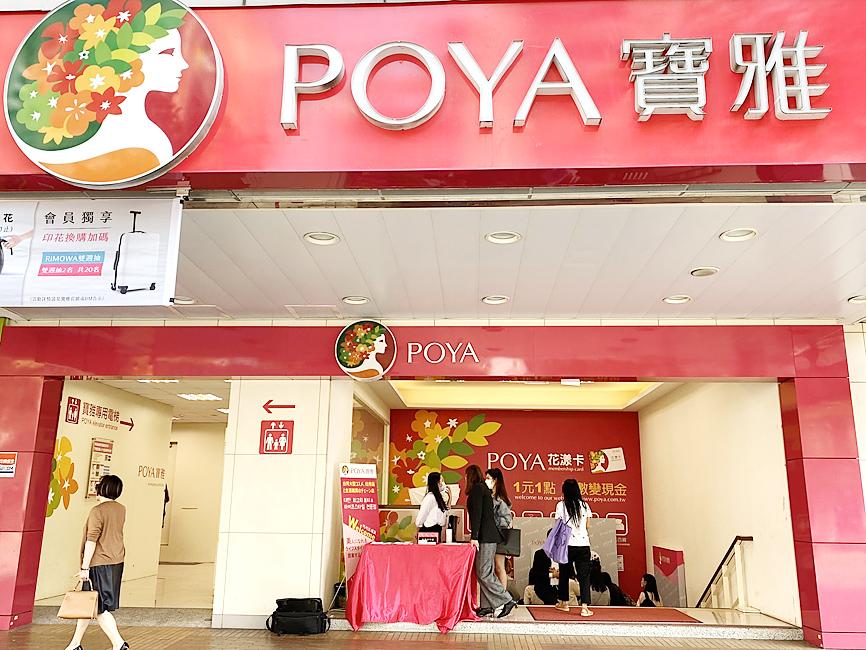Cosmetics chain operator Poya International Co Ltd (寶雅國際) is to see earnings grow 10 to 15 percent year-on-year this year, as store openings would offset lower-than-expected single-store sales during the COVID-19 pandemic, KGI Securities Investment Advisory Co (凱基投顧) said in a note.
With faster store expansion and better operating leverage, Poya’s earnings growth is likely to accelerate next year, KGI said on Tuesday.
As of Sept. 20, the company had 250 outlets in Taiwan selling cosmetics, lingerie and stationery, according to a presentation document on its Web site following an investors’ conference in Taipei on Monday last week.

Photo: Amy Yang, Taipei Times
“Poya is expected to open 5-10 new stores this quarter and increase its number of stores to 255-260 by the end of this year, which would neutralize the negative effects of slower growth in single-store sales due to decreased customer traffic,” analysts Angus Chuang (莊政翰) and Jenny Liu (劉昃恩) said in the note.
The company is also expected to launch more Poya Home (寶家) hardware stores, increasing from the current 15 to 30 by the end of the year, to create a second growth driver, they said.
It is expected to open 25 Poya outlets and 30 Poya Home stores next year, which would lift its earnings by 27 percent from this year, they added.
Poya is seeking faster expansion as storefronts come up for rent during the pandemic, while competitors Watsons Personal Care Stores (Taiwan) Co (台灣屈臣氏) and Tomod’s Inc have been downsizing.
Poya reported net profit grew 72.4 percent quarter-on-quarter and 37.1 percent year-on-year to NT$687.1 million (US$23.75 million) last quarter.
That translated into earnings per share (EPS) of NT$7.03, higher than KGI’s forecast of NT$6.07, as gross margin came in better than expected at 44.8 percent due to economies of scale, while operating margin hit a record high of 18.4 percent thanks to better workforce management.
The government’s Triple Stimulus Vouchers, corporate promotions, as well as new store openings helped revenue jump 20.9 percent from the previous quarter and 14.9 percent from the same period last year to NT$4.76 billion, a record high for a single quarter.
In the first three quarters of the year, net profit totaled NT$1.58 billion, up 14.5 percent from a year earlier, with EPS of NT$16.17.
Cumulative revenue increased 10.2 percent to NT$12.97 billion, with gross margin improving 0.52 percentage points to 43.23 percent and operating margin rising 0.02 percentage points to 15.16 percent, company data showed.
In light of the strong third-quarter results and Poya’s expansion strategy, KGI has adjusted its EPS forecast for this year from NT$21.15 to NT$21.96, and predicted that next year’s would reach NT$27.79.

TECH BOOST: New TSMC wafer fabs in Arizona are to dramatically improve US advanced chip production, a report by market research firm TrendForce said With Taiwan Semiconductor Manufacturing Co (TSMC, 台積電) pouring large funds into Arizona, the US is expected to see an improvement in its status to become the second-largest maker of advanced semiconductors in 2027, Taipei-based market researcher TrendForce Corp (集邦科技) said in a report last week. TrendForce estimates the US would account for a 21 percent share in the global advanced integrated circuit (IC) production market by 2027, sharply up from the current 9 percent, as TSMC is investing US$65 billion to build three wafer fabs in Arizona, the report said. TrendForce defined the advanced chipmaking processes as the 7-nanometer process or more

China’s Huawei Technologies Co (華為) plans to start mass-producing its most advanced artificial intelligence (AI) chip in the first quarter of next year, even as it struggles to make enough chips due to US restrictions, two people familiar with the matter said. The telecoms conglomerate has sent samples of the Ascend 910C — its newest chip, meant to rival those made by US chipmaker Nvidia Corp — to some technology firms and started taking orders, the sources told Reuters. The 910C is being made by top Chinese contract chipmaker Semiconductor Manufacturing International Corp (SMIC, 中芯) on its N+2 process, but a lack

Who would not want a social media audience that grows without new content? During the three years she paused production of her short do-it-yourself (DIY) farmer’s lifestyle videos, Chinese vlogger Li Ziqi (李子柒), 34, has seen her YouTube subscribers increase to 20.2 million from about 14 million. While YouTube is banned in China, her fan base there — although not the size of YouTube’s MrBeast, who has 330 million subscribers — is close to 100 million across the country’s social media platforms Douyin (抖音), Sina Weibo (新浪微博) and Xiaohongshu (小紅書). When Li finally released new videos last week — ending what has

NVIDIA PLATFORM: Hon Hai’s Mexican facility is to begin production early next year and a Taiwan site is to enter production next month, Nvidia wrote on its blog Hon Hai Precision Industry Co (鴻海精密), the world’s biggest electronics manufacturer, yesterday said it is expanding production capacity of artificial intelligence (AI) servers based on Nvidia Corp’s Blackwell chips in Taiwan, the US and Mexico to cope with rising demand. Hon Hai’s new AI-enabled factories are to use Nvidia’s Omnivores platform to create 3D digital twins to plan and simulate automated production lines at a factory in Hsinchu, the company said in a statement. Nvidia’s Omnivores platform is for developing industrial AI simulation applications and helps bring facilities online faster. Hon Hai’s Mexican facility is to begin production early next year and the